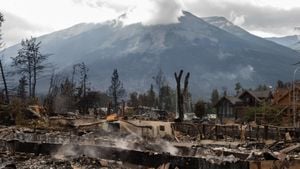Nuclear energy is making quite the splash lately, as major global events and ambitious government plans signal its potential resurgence. At the recent COP29 climate change conference, discussions intensified around how nuclear power could play a pivotal role in reducing carbon emissions—a mounting concern as the world grapples with climate change. Meanwhile, the Biden administration released a roadmap geared toward tripling nuclear energy production across the United States by 2050, demonstrating the government’s commitment to this energy source.
This uptick isn't happening in isolation. Companies like Amazon, Google, and Microsoft are also betting on nuclear, driven by their increasing energy needs for data centers, particularly with the rise of artificial intelligence workloads. To facilitate this, the Inflation Reduction Act has introduced substantial subsidies, enticing these tech giants to ink significant contracts for future nuclear energy projects. Google, for example, has partnered with Kairos Power for energy from small modular reactors (SMRs) starting as early as 2030—an agreement projected to provide enough power for over 400,000 homes.
So, what’s fueling this nuclear renaissance? The answer lies primarily within the innovative framework of small modular reactors. Unlike traditional nuclear plants—known for their hefty price tags and extensive construction timelines—SMRs promise easier, more affordable construction due to their smaller size and standardization. Mike Laufer, CEO of Kairos Power, emphasizes how traditional nuclear power plants often run over budget and behind schedule. With SMRs, the hope is to allow for more standard setups, which could translate to cost efficiency and faster deployment.
Historically, the U.S. has struggled with nuclear energy due to high costs and safety concerns stemming from past incidents like Three Mile Island, Chernobyl, and Fukushima. But as Laufer points out, the technological evolution represented by SMRs presents the chance to not only provide safer options but also manage the long-standing challenge of cost overruns. Conventional reactors have unique designs based on their locations and requirements, leading to unpredictable expenses—a situation SMRs aim to mitigate by offering uniformity.
Despite the optimism surrounding SMRs, the industry still faces hurdles. Infrastructure and regulatory approvals will need to align, particularly as processes can span years. For example, Oklo, another startup backing the concept of miniaturized reactors, has committed to delivering up to 750 megawatts to unnamed datacenter providers, tapping the potential of their fast fission reactor designs. Their first plant is slated for deployment by the end of the decade, pending the green light from the Nuclear Regulatory Commission, which will likely take additional time.
Oklo’s innovations stand out as they focus on utilizing recycled nuclear waste—fueling another angle of sustainability. Not only do they plan on running their reactors on recycled materials, but they also aim to roll out new recycling technologies by the early 2030s, potentially transforming how the industry thinks about nuclear waste.
Participation isn’t limited to tech ecopreneurs. Industry giants like Amazon and Oracle are also investing heavily. Amazon’s support for nuclear development reflects its ambition to power operations sustainably. Recently, it allocated $500 million to fund various nuclear projects, including partnerships for developing SMRs. Similarly, Oracle has announced plans for three reactors to support computing capabilities at its datacenters.
Despite this enthusiasm, experts warn potential pitfalls. The Institute for Energy Economics and Financial Analysis has described SMRs as carrying risks due to their expense and construction challenges. Projects like NuScale faced significant obstacles after municipalities showed hesitation due to their elevated cost structures. For the nuclear energy sector, history highlights the fine line between ambitious aspirations and the reality of execution.
Why the sudden enthusiasm from companies traditionally reliant on fossil fuels or renewable energy sources? A substantial reason is reliability. Nuclear power offers continuous energy generation, filling gaps during periods when solar or wind may be less productive. Still, it’s clear the transition to nuclear isn't without its critics. Environmental concerns around uranium mining and potential risks from radioactive waste generation continue to loom large over the discourse.
Yet, the Biden administration’s emphasis on achieving 200 gigawatts of new nuclear capacity reflects the growing acceptance of nuclear energy as part of the broader strategy for sustainable power generation. Goals laid out include ambitious interim targets for capacity additions, highlighting the administration’s vision to modernize the nuclear fleet, employing both existing infrastructure and groundbreaking new technologies.
This push for nuclear isn't exclusive to the United States; globally, there's momentum to increase nuclear capacity as part of the fight against climate change. Countries across the globe are recognizing nuclear's potential role as part of the energy transition, bolstered by innovations such as SMRs. With new reactor designs on the horizon and increasing investment from both government and private sectors, the future of nuclear energy seems poised for renewal.
Could this mean the dawn of what some proponents refer to as the nuclear renaissance? While big questions about safety, cost, and waste linger, the developments surrounding small modular reactors indicate there’s a growing appetite for this powerful energy source. Companies are gearing up to tap nuclear potential, not just for their own energy needs but also as part of the solution for climate-conscious power generation moving forward.



